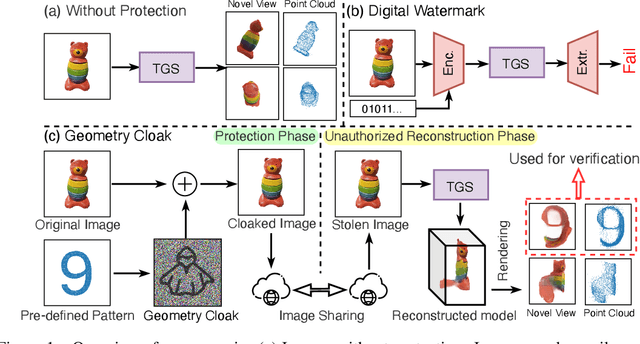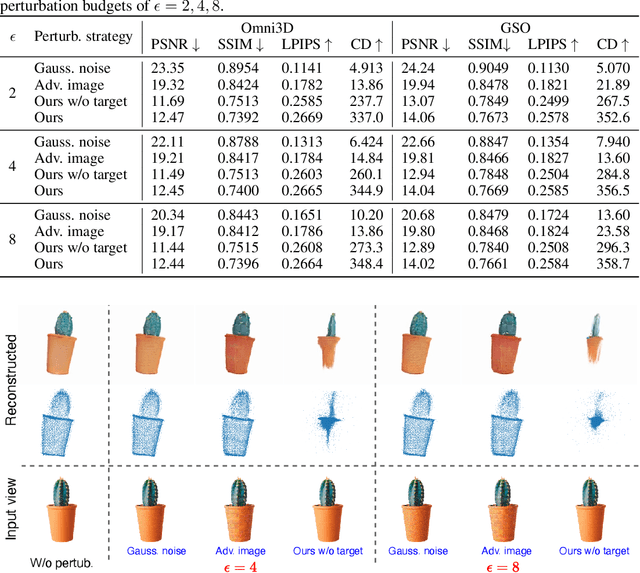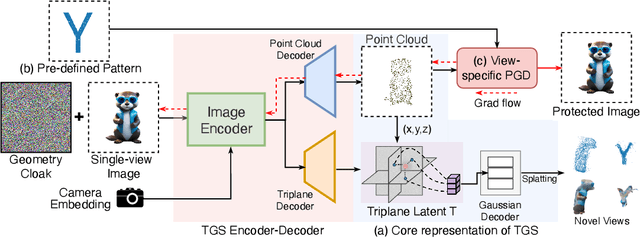Ziyuan Luo
The NeRF Signature: Codebook-Aided Watermarking for Neural Radiance Fields
Feb 26, 2025Abstract:Neural Radiance Fields (NeRF) have been gaining attention as a significant form of 3D content representation. With the proliferation of NeRF-based creations, the need for copyright protection has emerged as a critical issue. Although some approaches have been proposed to embed digital watermarks into NeRF, they often neglect essential model-level considerations and incur substantial time overheads, resulting in reduced imperceptibility and robustness, along with user inconvenience. In this paper, we extend the previous criteria for image watermarking to the model level and propose NeRF Signature, a novel watermarking method for NeRF. We employ a Codebook-aided Signature Embedding (CSE) that does not alter the model structure, thereby maintaining imperceptibility and enhancing robustness at the model level. Furthermore, after optimization, any desired signatures can be embedded through the CSE, and no fine-tuning is required when NeRF owners want to use new binary signatures. Then, we introduce a joint pose-patch encryption watermarking strategy to hide signatures into patches rendered from a specific viewpoint for higher robustness. In addition, we explore a Complexity-Aware Key Selection (CAKS) scheme to embed signatures in high visual complexity patches to enhance imperceptibility. The experimental results demonstrate that our method outperforms other baseline methods in terms of imperceptibility and robustness. The source code is available at: https://github.com/luo-ziyuan/NeRF_Signature.
CogSimulator: A Model for Simulating User Cognition & Behavior with Minimal Data for Tailored Cognitive Enhancement
Dec 10, 2024Abstract:The interplay between cognition and gaming, notably through educational games enhancing cognitive skills, has garnered significant attention in recent years. This research introduces the CogSimulator, a novel algorithm for simulating user cognition in small-group settings with minimal data, as the educational game Wordle exemplifies. The CogSimulator employs Wasserstein-1 distance and coordinates search optimization for hyperparameter tuning, enabling precise few-shot predictions in new game scenarios. Comparative experiments with the Wordle dataset illustrate that our model surpasses most conventional machine learning models in mean Wasserstein-1 distance, mean squared error, and mean accuracy, showcasing its efficacy in cognitive enhancement through tailored game design.
Geometry Cloak: Preventing TGS-based 3D Reconstruction from Copyrighted Images
Oct 30, 2024



Abstract:Single-view 3D reconstruction methods like Triplane Gaussian Splatting (TGS) have enabled high-quality 3D model generation from just a single image input within seconds. However, this capability raises concerns about potential misuse, where malicious users could exploit TGS to create unauthorized 3D models from copyrighted images. To prevent such infringement, we propose a novel image protection approach that embeds invisible geometry perturbations, termed "geometry cloaks", into images before supplying them to TGS. These carefully crafted perturbations encode a customized message that is revealed when TGS attempts 3D reconstructions of the cloaked image. Unlike conventional adversarial attacks that simply degrade output quality, our method forces TGS to fail the 3D reconstruction in a specific way - by generating an identifiable customized pattern that acts as a watermark. This watermark allows copyright holders to assert ownership over any attempted 3D reconstructions made from their protected images. Extensive experiments have verified the effectiveness of our geometry cloak. Our project is available at https://qsong2001.github.io/geometry_cloak.
Imaging Interiors: An Implicit Solution to Electromagnetic Inverse Scattering Problems
Jul 12, 2024Abstract:Electromagnetic Inverse Scattering Problems (EISP) have gained wide applications in computational imaging. By solving EISP, the internal relative permittivity of the scatterer can be non-invasively determined based on the scattered electromagnetic fields. Despite previous efforts to address EISP, achieving better solutions to this problem has remained elusive, due to the challenges posed by inversion and discretization. This paper tackles those challenges in EISP via an implicit approach. By representing the scatterer's relative permittivity as a continuous implicit representation, our method is able to address the low-resolution problems arising from discretization. Further, optimizing this implicit representation within a forward framework allows us to conveniently circumvent the challenges posed by inverse estimation. Our approach outperforms existing methods on standard benchmark datasets. Project page: https://luo-ziyuan.github.io/Imaging-Interiors
Protecting NeRFs' Copyright via Plug-And-Play Watermarking Base Model
Jul 10, 2024



Abstract:Neural Radiance Fields (NeRFs) have become a key method for 3D scene representation. With the rising prominence and influence of NeRF, safeguarding its intellectual property has become increasingly important. In this paper, we propose \textbf{NeRFProtector}, which adopts a plug-and-play strategy to protect NeRF's copyright during its creation. NeRFProtector utilizes a pre-trained watermarking base model, enabling NeRF creators to embed binary messages directly while creating their NeRF. Our plug-and-play property ensures NeRF creators can flexibly choose NeRF variants without excessive modifications. Leveraging our newly designed progressive distillation, we demonstrate performance on par with several leading-edge neural rendering methods. Our project is available at: \url{https://qsong2001.github.io/NeRFProtector}.
CopyRNeRF: Protecting the CopyRight of Neural Radiance Fields
Jul 29, 2023Abstract:Neural Radiance Fields (NeRF) have the potential to be a major representation of media. Since training a NeRF has never been an easy task, the protection of its model copyright should be a priority. In this paper, by analyzing the pros and cons of possible copyright protection solutions, we propose to protect the copyright of NeRF models by replacing the original color representation in NeRF with a watermarked color representation. Then, a distortion-resistant rendering scheme is designed to guarantee robust message extraction in 2D renderings of NeRF. Our proposed method can directly protect the copyright of NeRF models while maintaining high rendering quality and bit accuracy when compared among optional solutions.
 Add to Chrome
Add to Chrome Add to Firefox
Add to Firefox Add to Edge
Add to Edge